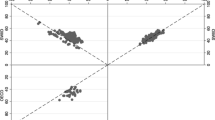Abstract
A comprehensive analysis of the causes, extent, and consequences of interregional differences in production and consumption indicators cannot be carried out based on a limited range of the most readily accessible statistical indicators. The most common of them—per capita GRP, average wages, and per capita cash incomes—are insufficient for obtaining objective conclusions and identifying all the factors that determine interregional differentiation; moreover, they lead to an overestimated scale of this differentiation. In addition, to estimate the extent of donor and receiver, it is also clearly insufficient to compare data on the volume of revenues in the budget system and expenditures of regional consolidated budgets. The article shows how drastic differences in interregional differentiation indicators can be when they are determined by diverse approaches.
Similar content being viewed by others
Notes
See: Unified interdepartmental information and statistical system. Indicators. Depreciation of fixed assets. www.fedstat.ru.
Data on tax revenues to the budget system from regions and industries are available on the website of the Federal Tax Service (www.nalog.ru). Volumes of federal budget revenues unbroken by regions (income from foreign economic activity, import VAT, etc.) are reflected in the Russian Statistical Yearbooks.
REFERENCES
Bufetova, A.N., Kolomak, E.A., and Mikhaleva, M.M., National diversity and economic development of Russian regions, Mir Ekon. Upr., 2017, vol. 17, no. 3, pp. 143–157.
Yershov, Yu.S., Features of regional economic development in Russia in 1999–2013, Reg. Res. Russ., 2016, vol. 6, no. 4, pp. 281–291.
Mel’nikova, L.V., City sizes, efficiency and economic growth, EKO, 2017, no. 7, pp. 5–19.
Suslov, V.I., Ershov, Yu.S., and Ibragimov, N.M., Macroeconomic interactions in Russia, Ekon. Strateg., 2016, no. 5 (139), pp. 64–71.
Funding
This study was carried out within the research plan of IEIE SB RAS as part of priority direction XI. 171 (project no. XI.171.1.2 “Study of Spatial Evolution Mechanisms and Modeling the Development of Spatial Systems”).
Author information
Authors and Affiliations
Corresponding author
Ethics declarations
The author declares that there is no conflict of interest.
Additional information
Translated by I. Pertsovskaya
Revised version of the article published in Region: Ekonomika i Sotsiologiya, 2019, no. 1 (101), pp. 3–22.
Rights and permissions
About this article
Cite this article
Ershov, Y.S. Interregional Differentiation and Donating and Recipient Regions: Diversity of Assessments and Conclusions. Reg. Res. Russ. 10, 20–28 (2020). https://doi.org/10.1134/S2079970520010037
Received:
Revised:
Accepted:
Published:
Issue Date:
DOI: https://doi.org/10.1134/S2079970520010037




